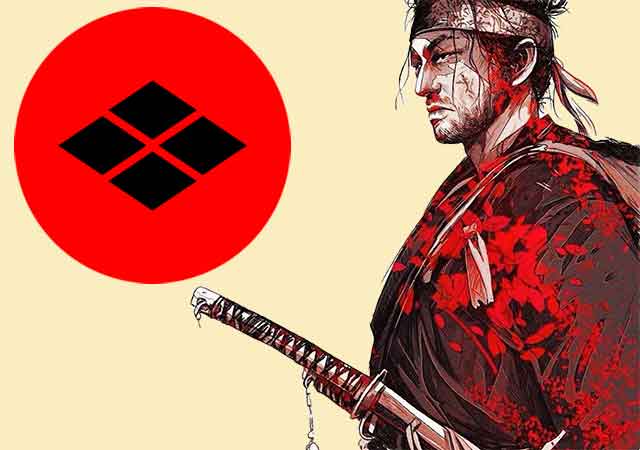
Baba Nobuharu (1514-15 – June 29, 1575), also known as Baba Nobufusa, was a renowned Japanese samurai during the Sengoku period. He gained fame as one of the "Twenty-Four Generals of Takeda Shingen." When Takeda Shingen captured Fukashi castle (now Matsumoto Castle) in 1550, he entrusted its guardianship to Baba.
Historical records indicate that from around 1553, Baba was tasked with overseeing the Suwa region in Shinano. This area served as a borderland with the northern Daimyo and played a crucial defensive role in monitoring potential invasions from the north. Additionally, he acted as an intermediary for the Shiina family of Etchu.
In 1557, Baba took part in the Kawanakajima campaigns, leading the Takeda forces in the siege and eventual destruction of Katsurayama, a significant stronghold of the Uesugi clan.
In 1562, he received the honor of assuming the title "Mino no Kami," a position previously held by Hara Toratane, who had retired the year before and changed his name to Baba Mino no Kami Nobuharu. The Kōyō Gunkan records that Shingen frequently sought Nobuharu's counsel on matters of importance. In 1572, he played a crucial role in the Siege of Iwamura Castle against the Oda clan garrison.
During the Battle of Mikatagahara in 1573, the troops under Nobuharu's command pursued Tokugawa Ieyasu's army back to Hamamatsu fortress. However, upon seeing the gates open and braziers lit, Baba mistakenly suspected a trap and chose not to further engage the fleeing army.
Following Takeda Shingen's passing, Baba continued to serve his successor, Takeda Katsuyori. In 1575, aware of Nobunaga's involvement in the Battle of Nagashino, he advised Katsuyori to withdraw. Unfortunately, Katsuyori disregarded this counsel.
Leading the right-wing of the Takeda army in the battle, Baba met his end in combat. It is believed that he sacrificed himself to cover the retreat, allowing Katsuyori to escape the battlefield. The deaths of Baba Nobuharu, along with other valiant warriors such as Sanada Nobutsuna, Naito Masayo, and Yamagata Masakage, during the Battle of Nagashino contributed to the weakening and eventual downfall of the Takeda family in 1582.
Prior to Nagashino, Nobuharu had earned a reputation for fighting in 70 battles without sustaining a single injury. This remarkable feat has immortalized him as "Baba Mino the Immortal" or "Oni Mino the Immortal" in modern memory.
See also
-
Yamagata Masakage

Masakage was one of Takeda Shingen’s most loyal and capable commanders. He was included in the famous list of the “Twenty-Four Generals of Takeda Shingen” and also belonged to the inner circle of four especially trusted warlords known as the Shitennō.
-
Yagyu Munenori

Yagyū Munenori began his service under Tokugawa Ieyasu while his father, Yagyū Muneyoshi, was still at his side. In 1600, Munenori took part in the decisive Battle of Sekigahara. As early as 1601, he was appointed a kenjutsu instructor to Tokugawa Hidetada, Ieyasu’s son, who later became the second shogun of the Tokugawa clan.
-
Yagyu Muneyoshi

A samurai from Yamato Province, he was born into a family that had been defeated in its struggle against the Tsutsui clan. Muneyoshi first took part in battle at the age of sixteen. Due to circumstances beyond his control, he was forced to enter the service of the Tsutsui house and later served Miyoshi Tōkei. He subsequently came under the command of Matsunaga Hisahide and in time became a vassal first of Oda and later of Toyotomi.
-
Endo Naozune

Naozune served under Azai Nagamasa and was one of the clan’s leading vassals, renowned for his bravery and determination. He accompanied Nagamasa during his first meeting with Oda Nobunaga and at that time asked for permission to kill Nobunaga, fearing him as an extremely dangerous man; however, Nagamasa did not grant this request.
-
Hosokawa Sumimoto

Sumimoto came from the Hosokawa clan: he was the biological son of Hosokawa Yoshiharu and at the same time the adopted son of Hosokawa Masamoto, the heir of Hosokawa Katsumoto, one of the principal instigators of the Ōnin War. Masamoto was homosexual, never married, and had no children of his own. At first he adopted Sumiyuki, a scion of the aristocratic Kujō family, but this choice provoked dissatisfaction and sharp criticism from the senior vassals of the Hosokawa house. As a result, Masamoto changed his decision and proclaimed Sumimoto as his heir, a representative of a collateral branch of the Hosokawa clan that had long been based in Awa Province on the island of Shikoku. Almost immediately after this, the boy became entangled in a complex and bitter web of political intrigue.
-
Honda Masanobu

Masanobu initially belonged to the retinue of Tokugawa Ieyasu, but later entered the service of Sakai Shōgen, a daimyo and priest from Ueno. This shift automatically made him an enemy of Ieyasu, who was engaged in conflict with the Ikkō-ikki movement in Mikawa Province. After the Ikkō-ikki were defeated in 1564, Masanobu was forced to flee, but in time he returned and once again entered Ieyasu’s service. He did not gain fame as a military commander due to a wound sustained in his youth; nevertheless, over the following fifty years he consistently remained loyal to Ieyasu.
-
Honda Masazumi

Masazumi was the eldest son of Honda Masanobu. From a young age, he served Tokugawa Ieyasu alongside his father, taking part in the affairs of the Tokugawa house and gradually gaining experience in both military and administrative matters. At the decisive Battle of Sekigahara in 1600, Masazumi was part of the core Tokugawa forces, a clear sign of the high level of trust Ieyasu placed in him. After the campaign ended, he was given a highly sensitive assignment—serving in the guard of the defeated Ishida Mitsunari, one of Tokugawa’s principal enemies—an obligation that required exceptional reliability and caution.
-
Hojo Shigetoki

Hōjō Shigetoki, the third son of Hōjō Yoshitoki, was still very young—only five years old—when his grandfather Tokimasa became the first member of the Hōjō clan to assume the position of shogunal regent.

